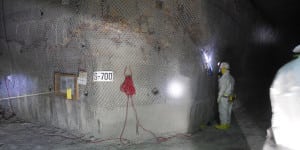
Another underground rockfall prompted workers to evacuate from the Waste Isolation Pilot Plant (WIPP) on Thursday, the Energy Department said.
The collapse occurred even as WIPP prime contractor Nuclear Waste Partnership (NWP) prepares to welcome DOE officials Nov. 14 for the final review standing in the way of reopening the deep-underground transuranic waste-storage facility, which has been closed for more nearly three years.
No one was hurt in the apparent collapse Thursday, and there was no release of radiation after “[e]mployees working in the area of Panel 7 in the WIPP underground reported a loud noise and observed salt dust indicating a possible rock fall,” DOE stated in the online note.
Workers subsequently left the underground and had not returned to work at deadline Friday afternoon for Weapons Complex Monitor. However, “[a] team, consisting of mine rescue, geotechnical and radiological control personnel, is developing a plan to re-enter the underground on Nov. 4 to determine the exact location and extent of the rock fall,” the department said.
Panel 7 is where an improperly packaged container of transuranic waste burst open in 2014, causing an underground radiation leak.
This was the fourth underground rockfall at the WIPP since late September. The four collapses this year happened in areas of the mine to which access had been prohibited following the 2014 accident radiation release and earlier, unrelated underground fire.
Barring access, DOE knew, meant accepting that WIPP’s naturally shifting salt ceilings would go without the maintenance required to keep them from collapsing in those areas. With the rockfalls mounting, DOE and NWP decided in October to close down the southern end of the mine, where available storage space is essentially used up anyway.
The decision does deprive DOE of about another three football fields’ worth of usable storage space, but at the slow rate of waste-emplacement envisioned after the reopening, the agency says it would not need that area for years, anyway.
Mine maintenance continues in WIPP’s north end, which has plenty of empty waste disposal space waiting to be filled. DOE must file a permit modification request with the New Mexico Environment Department before it can begin the partial mine closure. The agency had not done that at deadline for Weapons Complex Monitor, but a Carlsbad city official has said closure work could start by Dec. 31.
WIPP is the only permanent disposal space for the radiologically contaminated equipment and material known as transuranic waste. The facility is expected to reopen in December or January, and to begin accepting new shipments of transuranic waste from former weapons-production sites across the country by April.
The rockfalls, DOE has insisted, will not affect the timetable for reopening WIPP. NWP recently finished the contractor operational readiness review that is the penultimate step in reopening the mine, and in just 11 days. The evaluation was scheduled to last 27 days and was originally to start in mid-June, according to a public schedule the agency published in February.
The review actually began Oct. 3 and wrapped up Oct. 14. That means DOE clawed back about two weeks of schedule on the WIPP restart plan it published earlier this year.
Prior to the quick contractor operational readiness review, DOE and NWP had been about a month behind schedule to reopen WIPP by the official target of Dec. 12. While the two-week time-saver would appear to keep that date out of reach, reopening the deep-underground salt mine by Dec. 31 is now possible — assuming DOE and the New Mexico Environment Department do not find any show-stoppers in their own inspections.
The DOE operational readiness review is nominally slated for Nov. 14. New Mexico’s inspection would follow that.
In an emailed statement Tuesday, New Mexico Environment Secretary Butch Tongate would not comment on DOE’s timeline, but wrote that “we’re continuing to work with WIPP and DOE leadership to protect the safety of workers, communities in the area, and the surrounding environment.”